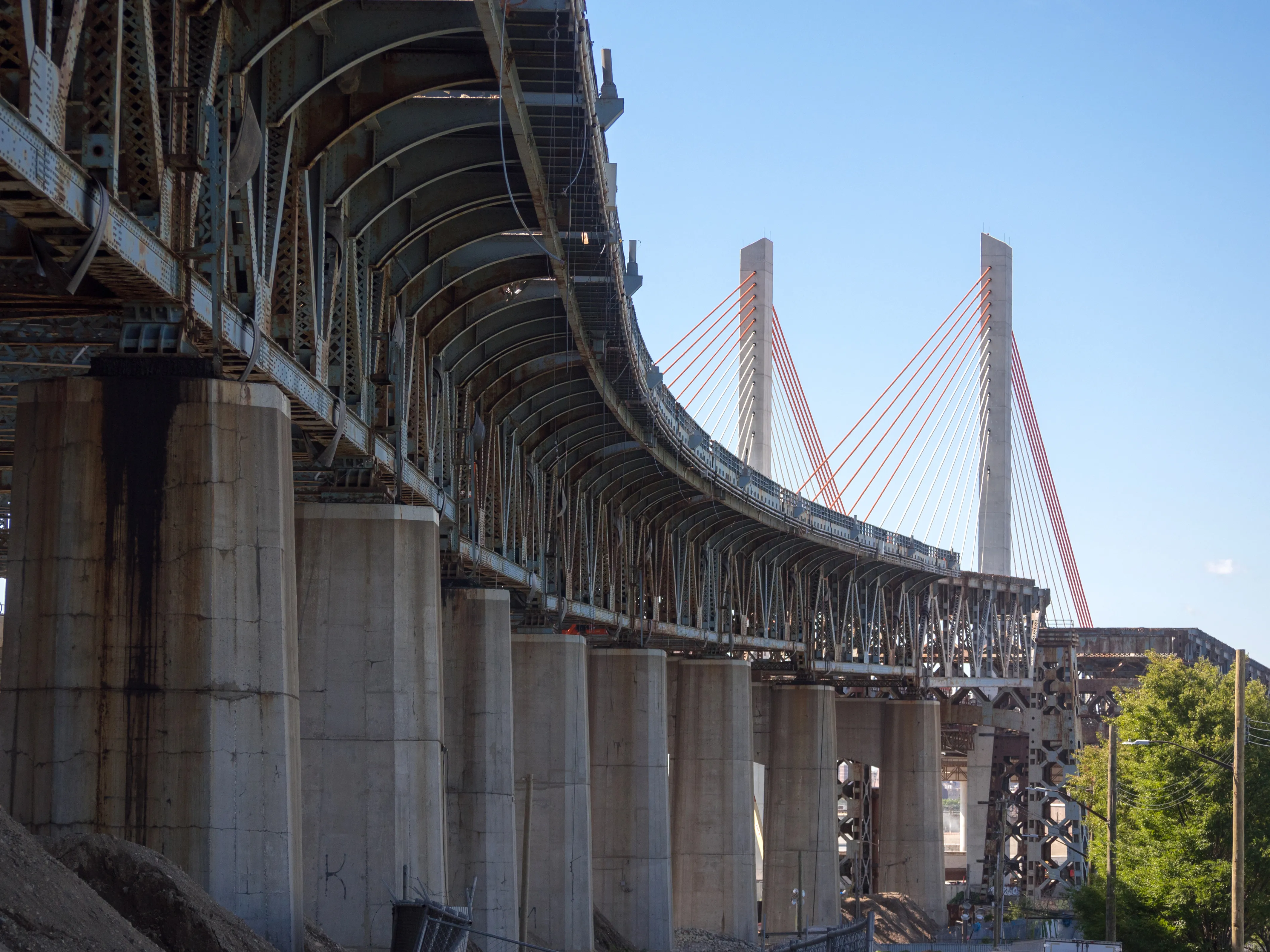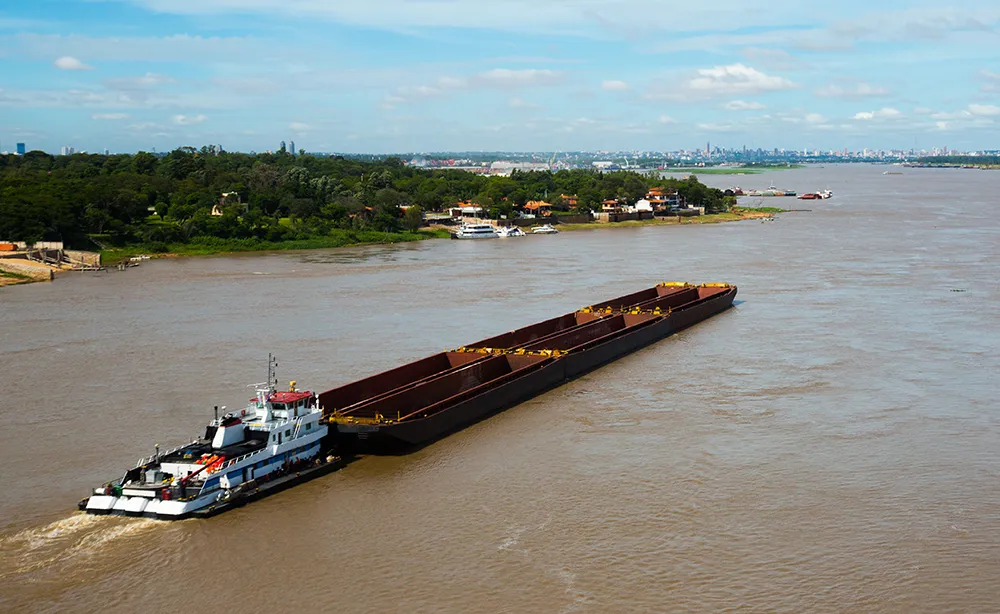An Indeco ISS 45/90 is proving essential for demolishing the old Kosciuszko Bridge in New York City. New York City’s old 1.9km Kosciuszko Bridge, which crosses Newtown Creek connecting Green Point, Brooklyn with Maspeth, Queens, has been out of service since April. By the end of the year, the polygonal Warren through-truss structure will be no more.
To replace the old bridge, in 2009, the New York State Department of Transportation planned the construction of two cable-stayed replacement bridges.
November 23, 2017
Read time: 5 mins

An 237 Indeco ISS 45/90 is proving essential for demolishing the old Kosciuszko Bridge in New York City
New York City’s old 1.9km Kosciuszko Bridge, which crosses Newtown Creek connecting Green Point, Brooklyn with Maspeth, Queens, has been out of service since April. By the end of the year, the polygonal Warren through-truss structure will be no more.
To replace the old bridge, in 2009, the1431 New York State Department of Transportation planned the construction of two cable-stayed replacement bridges.
The first of the two new bridges located south of the old truss bridge opened in April. After demolition of the old bridge, a new westbound cable-stayed bridge, including four lanes and a bike-walkway, will be built on the site of the old bridge.
Construction of the first new bridge was awarded to a joint venture made up of Skanska-Kiewit-ECCO III Enterprises, which finished building the first bridge last April. The JV is also in charge of demolishing the entire old bridge to allow construction of the second new bridge. Demolition officially started July 24 when the main 91m span was taken down.
Demolition of the main span consisted of a strand jacking system to lower the 2,270tonne structure – 27m wide and 15.2m high - down 38m and onto two barges on Newtown Creek. The barges were then tugged to the East River and from there to a recycling facility where the main span will be demolished.
To demolish the approaches of the 21 spans ranging from 36-70m and which were resting on reinforced concrete piers, it was decided to section the deck and weaken the main members. This included girders and stringers, by cutting in defined areas and then placing a small amount of charges in key points to collapse the structure onto a bed of dirt piled under the various spans. This would create a damping effect.
Once collapsed, the spans are to be cut and taken to a recycling plant. The remaining piers will be demolished using large hydraulic hammers.
The demolition process was subcontracted to New York demolition business Breeze. The company decided to make minimal use of flame-cutting, confining it to areas only where a mechanical method could not be used. Instead, the company would employ shears – in this case a new ISS 45/90 from Indeco.
In September, demolition started with the initial span on the Queens side. This span, unlike the others which are later to be collapsed all at the same time by blasting, had to be taken down entirely by mechanical means.
Collapsing the first span using explosives could have induced structural stresses to the rest of the spans that were being prepared for blasting. Weakened by cuts and deck-sectioned, demolition of both approaches will involve cutting around 31,500tonnes of steel and demolishing and crushing around 68,000m³ of reinforced concrete that comprises the piers.
To get demolition done in the assigned 17 weeks, Breeze will use a fleet of machines and demolition attachments as well as other service equipment on site. The reason for such tight scheduling is because construction of the second bridge cannot begin if demolition of the old structure - first Queens side, then Brooklyn - is not complete.
According to original drawings of the bridge, structural members are of either silicon steel or carbon steel with thickness up to just over 5cm. Some elements are particularly difficult to cut such as the top chord which is 34cm high and 54cm wide at the top and comprising plates with thickness of 32mm, 19mm, 16mm and 13mm.
The contractor Breeze is a long-time user of Indeco equipment, owning 22 hammers, two shears and two multi-grabs. For the old Kosciuszko Bridge job, the contractor bought an ISS 45/90, the largest of the manufacturer’s range available from Indeco dealer Alessi Equipment. Apart from brand loyalty, there were good technical reasons for the purchase. The ISS 45/90 is best in its weight class (9,700kg) in terms of clamping force (2,500tonnes). Maximum force at the tip is 275tonnes and the jaw opening is 1,100mm.
The ISS 45/90, like all other Indeco shears, also has a very favourable weight-to-power ratio. Structurally speaking, the attachment is made entirely of extra-strength Hardox . A heavy-duty pivot unit which provides long-term cutting efficiency, keeps the jaws aligned and prevents buckling. Alignment to prevent deflection in both directions during the cutting cycle - a critical point for every shear- is assured by a dual guide pack system that can infinitely adjust it.
In terms of power delivery, the ISS 45/90 relies on the oversized cylinder design that can withstand 700bar of pressure to handle any type of working condition. Power is also helped by double integrated regeneration valves, together with the exclusive cylinder design to speed up no-load opening and closing of the jaw. The result reduces cycle times.
To further enhance performance, the V-Ripper Razor Dual piercing design of both the upper and lower jaws improves cutting ability. The shears have full high-speed 360° hydraulic rotation for better positioning and optimal cutting in any situation. This feature proved immediately useful in cutting the intricate structure of the first span, which entailed the jaw’s position to be constantly rotated to reach and cut the steel element.
The attachment is coupled to a2300 Komatsu PC 800 via an original Indeco special mounting bracket specifically adapted to fit the boom carrier.
New York City’s old 1.9km Kosciuszko Bridge, which crosses Newtown Creek connecting Green Point, Brooklyn with Maspeth, Queens, has been out of service since April. By the end of the year, the polygonal Warren through-truss structure will be no more.
To replace the old bridge, in 2009, the
The first of the two new bridges located south of the old truss bridge opened in April. After demolition of the old bridge, a new westbound cable-stayed bridge, including four lanes and a bike-walkway, will be built on the site of the old bridge.
Construction of the first new bridge was awarded to a joint venture made up of Skanska-Kiewit-ECCO III Enterprises, which finished building the first bridge last April. The JV is also in charge of demolishing the entire old bridge to allow construction of the second new bridge. Demolition officially started July 24 when the main 91m span was taken down.
Demolition of the main span consisted of a strand jacking system to lower the 2,270tonne structure – 27m wide and 15.2m high - down 38m and onto two barges on Newtown Creek. The barges were then tugged to the East River and from there to a recycling facility where the main span will be demolished.
To demolish the approaches of the 21 spans ranging from 36-70m and which were resting on reinforced concrete piers, it was decided to section the deck and weaken the main members. This included girders and stringers, by cutting in defined areas and then placing a small amount of charges in key points to collapse the structure onto a bed of dirt piled under the various spans. This would create a damping effect.
Once collapsed, the spans are to be cut and taken to a recycling plant. The remaining piers will be demolished using large hydraulic hammers.
It’s a Breeze
The demolition process was subcontracted to New York demolition business Breeze. The company decided to make minimal use of flame-cutting, confining it to areas only where a mechanical method could not be used. Instead, the company would employ shears – in this case a new ISS 45/90 from Indeco.
In September, demolition started with the initial span on the Queens side. This span, unlike the others which are later to be collapsed all at the same time by blasting, had to be taken down entirely by mechanical means.
Collapsing the first span using explosives could have induced structural stresses to the rest of the spans that were being prepared for blasting. Weakened by cuts and deck-sectioned, demolition of both approaches will involve cutting around 31,500tonnes of steel and demolishing and crushing around 68,000m³ of reinforced concrete that comprises the piers.
To get demolition done in the assigned 17 weeks, Breeze will use a fleet of machines and demolition attachments as well as other service equipment on site. The reason for such tight scheduling is because construction of the second bridge cannot begin if demolition of the old structure - first Queens side, then Brooklyn - is not complete.
Big job, big shears
According to original drawings of the bridge, structural members are of either silicon steel or carbon steel with thickness up to just over 5cm. Some elements are particularly difficult to cut such as the top chord which is 34cm high and 54cm wide at the top and comprising plates with thickness of 32mm, 19mm, 16mm and 13mm.
The contractor Breeze is a long-time user of Indeco equipment, owning 22 hammers, two shears and two multi-grabs. For the old Kosciuszko Bridge job, the contractor bought an ISS 45/90, the largest of the manufacturer’s range available from Indeco dealer Alessi Equipment. Apart from brand loyalty, there were good technical reasons for the purchase. The ISS 45/90 is best in its weight class (9,700kg) in terms of clamping force (2,500tonnes). Maximum force at the tip is 275tonnes and the jaw opening is 1,100mm.
The ISS 45/90, like all other Indeco shears, also has a very favourable weight-to-power ratio. Structurally speaking, the attachment is made entirely of extra-strength Hardox . A heavy-duty pivot unit which provides long-term cutting efficiency, keeps the jaws aligned and prevents buckling. Alignment to prevent deflection in both directions during the cutting cycle - a critical point for every shear- is assured by a dual guide pack system that can infinitely adjust it.
In terms of power delivery, the ISS 45/90 relies on the oversized cylinder design that can withstand 700bar of pressure to handle any type of working condition. Power is also helped by double integrated regeneration valves, together with the exclusive cylinder design to speed up no-load opening and closing of the jaw. The result reduces cycle times.
To further enhance performance, the V-Ripper Razor Dual piercing design of both the upper and lower jaws improves cutting ability. The shears have full high-speed 360° hydraulic rotation for better positioning and optimal cutting in any situation. This feature proved immediately useful in cutting the intricate structure of the first span, which entailed the jaw’s position to be constantly rotated to reach and cut the steel element.
The attachment is coupled to a









